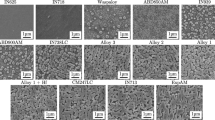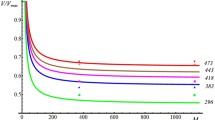Abstract
Advancements in nanotechnology for material processing via combustion synthesis have spurred the development of superalloys that provide improved protective properties. Nanoscalereactant particles offer unique thermal properties and increased homogeneity that improve the microstructural features and macroscopic properties of the synthesized product. In this study nanoscale molybdenum trioxide (MoO3) particles were added to micron scale nickel (Ni) and aluminum (Al). The goal was to incorporate a nanoscale additive within thereactant matrix that would produce a superalloy by generating excessively high heating rates and creating controlled quantities of Al2O3 (a strengthening agent) within the microstructure of the alloy. Ignition and flame propagation were examined using a CO2 laser and imaging diagnostics that include a copper-vapor laser coupled with a high-speed camera. Product microstructure was examined using micro-x-ray diffraction analysis and scanning electron microscopy. Abrasion testing was performed to evaluate the wear resistance properties of the superalloy.results show that adding MoO3 increases the flame temperature,results in greater ignition sensitivity, produces a more homogeneous microstructure, and increases the overall wearresistance of the product.
Similar content being viewed by others
References
Z.Z. Mutasim: Internal Technical Report No. TTS-117-398-2M (Solar Turbines Inc., San Diego, CA, 1998).
M. Batham, A. Bining, K. Birkinshaw, D. Hatfield, M. Magaletti, M. Pantoya, and A. Soinski: California Energy Commission Report CEC-EPAG-2000 (2000).
J. Eckert, J.C. Holzer, C.C. Ahn, Z. Fu, and W.L. Johnson: Melting behavior of nanocrystalline aluminum powders. Nanostruct. Mater. 2, 407 (1993).
J.J. Granier and M.L. Pantoya: Laser ignition of nanocomposite thermites. Combustion Flame (2004, in press).
U. Anselmi-Tamburini, F. Maglia, S. Doppiu, M. Monagheddu, G. Cocco, and Z.A. Munir: Ignition mechanism of mechanically activated Me–Si (Me _ Ti, Nb, Mo) mixtures. J. Mater. Res. 19, 1558 (2004).
C. Gras, F. Charlot, E. Gaffet, F. Bernard, and J.C. Niepce: In situ synchrotron characterization of mechanically activated selfpropagating high temperature syntehsis applied in Mo–Si System. Acta Mater. 47, 2113 (1999).
E.M. Hunt, K.B. Plantier, and M.L. Pantoya: Nano-scale Reac- tants in the SHS of Nickel Aluminides. Acta Mater. 52, 3183 (2004).
J.J. Granier, K.B. Plantier, and M.L. Pantoya: The role of the Al2O3 passivation shell surrounding-aluminum particles in the combustion synthesis of NiAl. (2003, unpublished).
C.R.M. Wronski: The size dependence of the melting point of small particles of tin. Brit. J. Appl. Phys. 18, 1731 (1967).
B.S. Bockmon, M.L. Pantoya, S.F. Son, B.W. Asay, and J.T. Mang: Burn rate measurements of nanocomposite thermites. In Modeling, Diagnostics Session; Proceedings of the 41st auAA Aerospace Sciences Meeting, Energetic Materials: Reno, NV, 2003; auAA-2003-0241.
L.L. Wang, Z.A. Munir, and Y.M. Maximov: Thermite Reactions: Their utilization in the synthesis and processing of materials. J. Mater. Sci. 28, 3693 (1993).
Y.C. Liau, E.S. Kim, and V. Yang: A comprehensive analysis of laser-induced ignition of RDX monopropellant. Combustion Flame 126, 1680 (2001).
H. Ostmark and N. Roman: Laser ignition of pyrotechnic mixtures: Ignition mechanisms. J. Appl. Phys. 73(4), 1993 (1993).
R.J. Harrach: Estimates on the ignition of high-explosives by laser pulses. J. Appl. Phys. 47(6), 2473 (1976).
S.H. Fisher and M.C. Grubelich: Theoretical Energy Release of Thermites, Intermetallics, and Combustible Metals. In 24th International Pyrotechnics Seminar, July (1998).
J-P. Lebrat and A. Varma: Mechanistic studies in combustion synthesis of Ni3Al-matrix composites. J. Mater. Res. 9, 1184 (1994).
W.F. Smith: Foundations of Materials Science and Engineering (Irwin/McGraw-Hill, 1993).
J.J. Moore: An Examination of the Thermochemistry of Combustion Synthesis Reactions. In Processing and Fabrication of Advanced Materials III (The Minerals, Metals, and Materials Society, Warrendale, PA, 1994).
Eagle Alloys Corporation, Talbott, TN. Product information website: www.eaglealloys.com (2004).
Author information
Authors and Affiliations
Rights and permissions
About this article
Cite this article
Hunt, E.M., Granier, J.J., Plantier, K.B. et al. Nickel aluminum superalloys created by the self-propagating high-temperature synthesis of nanoparticlereactants. Journal of Materials Research 19, 3028–3036 (2004). https://doi.org/10.1557/JMR.2004.0389
Received:
Accepted:
Published:
Issue Date:
DOI: https://doi.org/10.1557/JMR.2004.0389




